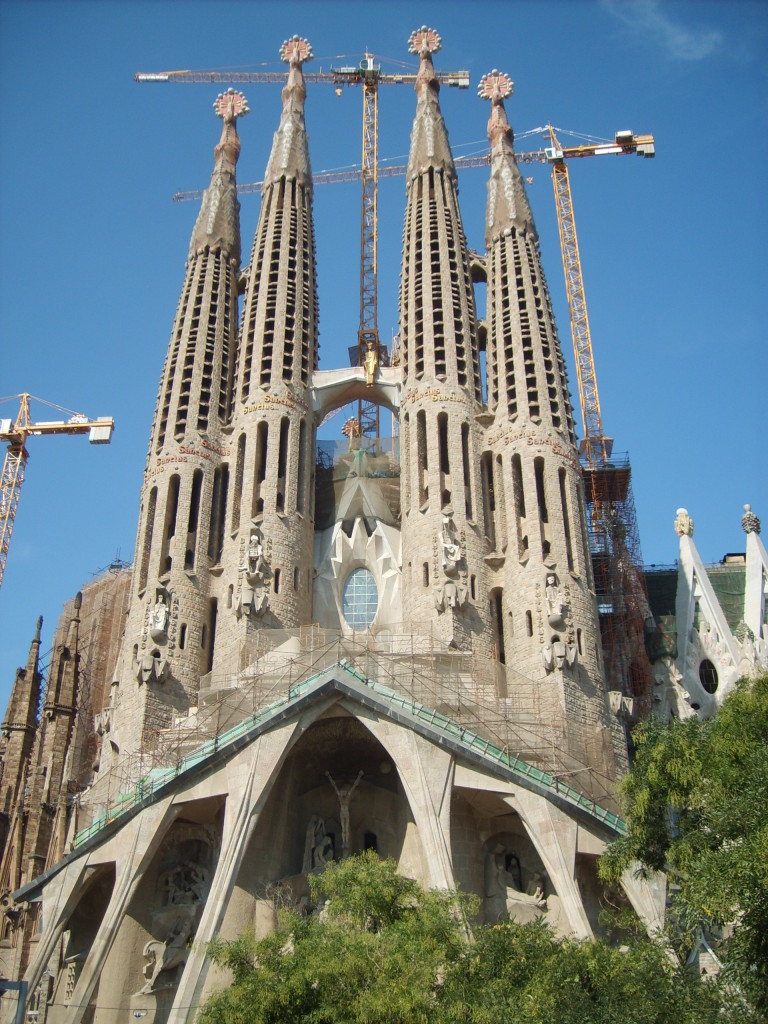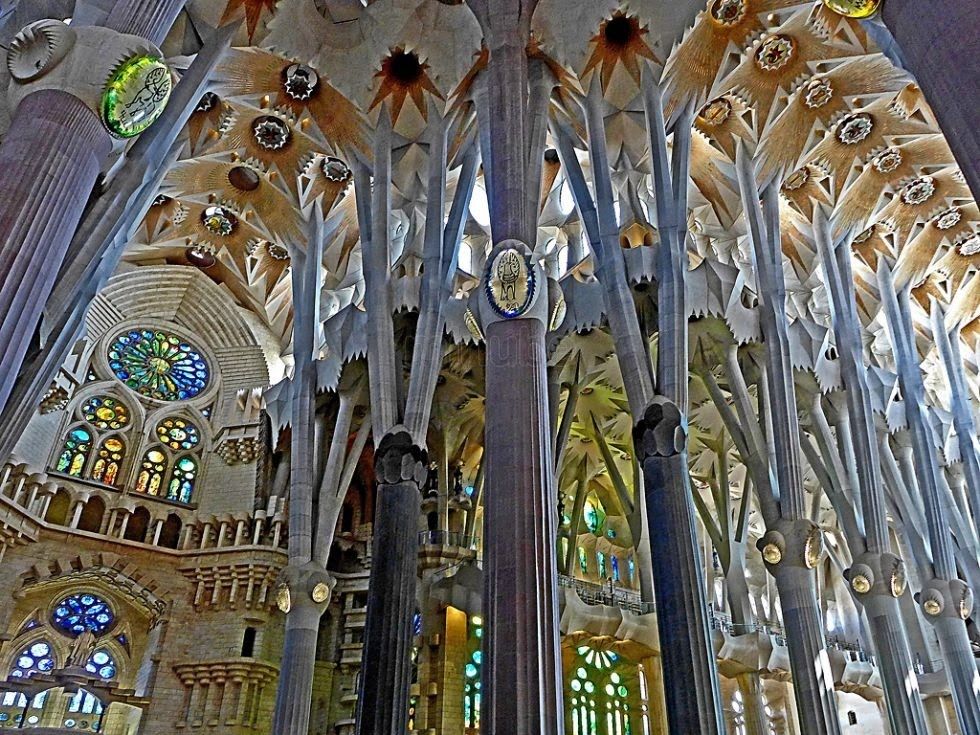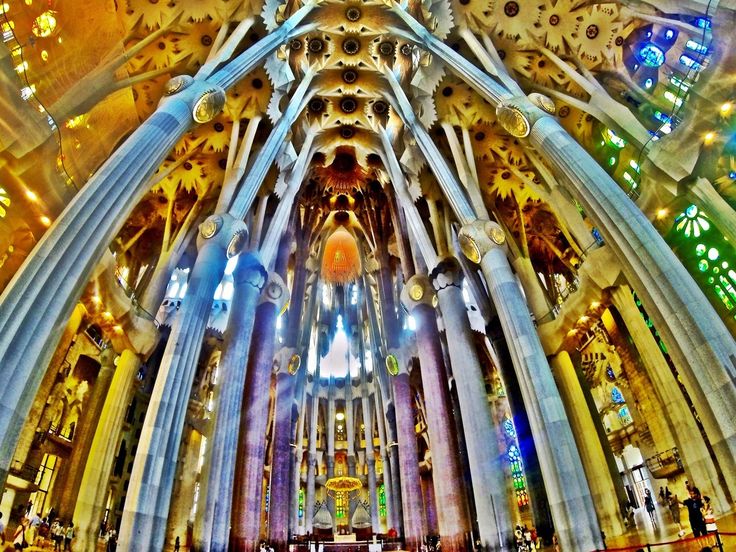Imágenes, de De sagrada familia, fotos e imágenes de stock de De sagrada familia
Descubra millones de imágenes de alta resolución de De sagrada familia y visuales de stock para uso comercial.
Cropped view of muslim father giving book to son with prayer beads at home, banner
Mujeres multiétnicas y niños rezando sobre alfombras con patrón oriental en casa
Muslim father holding book and looking at son on couch at home
Vista trasera del niño musulmán rezando cerca de papá y abuelo en casa
Vista lateral del niño rizado musulmán rezando cerca de los padres interracial en casa
Vista lateral de la chica en hijab tomados de la mano cerca de la cara mientras se reza cerca de la familia multiétnica
Vista aérea del niño adolescente rezando cerca de mamá en casa
Vista lateral del joven árabe rezando cerca de su hijo y papá borroso en casa
Vista de ángulo bajo de la mujer árabe rezando cerca de hija borrosa en casa
Mujer asiática con ropa tradicional musulmana rezando cerca de la hija y nieta árabe en casa
Vista recortada de la mujer musulmana rezando en casa
Vista recortada del hombre musulmán rezando cerca de chico borroso en casa, pancarta
Mujer musulmana rezando y doblándose en la alfombra cerca de la familia en casa
Hombre maduro rezando cerca de padre e hijo musulmán en casa
Middle eastern man looking at son near blurred book at home, banner
Arabian man holding prayer beads while talking to son with blurred book at home
Vista recortada del niño árabe sentado en la alfombra cerca de la familia en casa, pancarta
Vista lateral del hombre de mediana edad rezando en la alfombra borrosa en casa
Chica adolescente rezando cerca de las mujeres borrosas en casa
Cropped view of muslim father giving book to son with prayer beads at home
Vista parcial del hombre apoyando a la madre mayor con rosario de madera
Vista de ángulo bajo del hombre árabe barbudo cerca de padre maduro rezando en casa
Mujeres y niñas multiétnicas en hiyabs doblándose en trapos en casa
Vista parcial del hombre que apoya a la madre mayor con pelo gris
Vista recortada de mujeres musulmanas rezando en casa
Padre de mediana edad e hijo árabe rezando en casa
Los hombres árabes y los niños se doblan en las alfombras mientras rezan en casa
Blurred muslim dad with prayer beads near smiling son holding book at home
Muslim man reading book near son on couch at home
Vista recortada de mujeres musulmanas con ropa tradicional rezando sobre alfombras en casa
Hombre maduro rezando con los ojos cerrados cerca de hijo y niño musulmán en casa
Muslim boy looking at dad near blurred book at home
Vista lateral del hombre maduro rezando con los ojos cerrados cerca borrosa hijo árabe en casa
Muslim man holding prayer beads near preteen son with book on couch at home
Vista lateral del niño preadolescente árabe en ropa tradicional rezando cerca de los hombres en casa
Niño rizado musulmán rezando en la alfombra cerca de padre y abuelo en casa
Interracial hombres y musulmán chico doblez mientras orar en casa
Vista recortada del niño preadolescente musulmán sentado en la alfombra tradicional mientras rezaba con la familia en casa
Hombre árabe joven rezando cerca de borrosa hijo y padre en casa
Hombres multiétnicos y chico árabe rezando en alfombras en casa
Cropped view of muslim man with prayer beads giving book to son at home
Vista parcial de la mujer mayor con rosario cogido de la mano con el hijo
Muslim boy reading book with father on couch at home
Chico árabe rizado cogido de la mano cerca de la cara mientras rezaba cerca de un padre borroso en casa
Muslim man hugging son and holding prayer beads while reading book at home
Joven mujer musulmana rezando cerca borrosa hija adolescente en casa
Cropped view of blurred muslim dad giving koran to son with prayer beads at home
Hombre maduro rezando cerca borrosa nieto musulmán e hijo en casa
Mujeres y niños interraciales en hiyabs orando sobre alfombras en casa
Vista lateral del joven musulmán rezando cerca de padre e hijo en alfombras en casa
La Sagrada Família de Antoni Gaudí
Al final de esta página encontrarás una extensa guía de fotos de La Sagrada Família de Antoni Gaudí. Las fotos fueron tomadas en el sentido de las agujas del reloj, recorriendo los 360º alrededor del edificio.
La Sagrada Família es la atracción turística más visitada de Barcelona, atendiendo a más de 2.000.000 visitantes cada año . Es un trabajo de proporciones inmensas y el Mundo de la Arquitectura la considera como una de las construcciones modernas más originales y ambiciosas.
Mapa que muestra la ubicación de la Sagrada Família
Tetuan Metro
Este mapa está registrado y protegido por derechos de autor y no puede ser copiado.
Hospital de Sant Pau Metro
Sagrada Família Hotel
Abalon Hotel
Medicis Hotel
Acta Antibes Hotel Barcelona
Aranea Hotel Barcelona
Carlit Hesperia Hotel
Eurostars Cristal Palace Hotel
Sagrada Família
Carrer de Mallorca, 401
Sagrada Família Metro
Sagrada Família Metro
Verdaguer Metro
Monumental Metro
Aparcamiento PROMOPARC Industria 9
Aparcamiento BSM Avenida Gaudí
Aparcamiento Rasina House
Aparcamiento BSM Sagrada Família
Aparcamiento NN Valencia III
Aparcamiento NN Valenica
Como puedes ver, el edificio todavía está en construcción y no será terminado en los próximos 20 / 25 años.
Cómo llegar:
Carrer Mallorca, 401
Metro: Sagrada Família (Línea Azul, L5) y (Línea Púrpura, L2) mapa del metro de Barcelona
Horarios de Atención:
| 01 enero y 06 enero | domingo y viernes | 09:00 – 14:00 |
| enero – febrero | lunes – sábado | 9:00 – 18:00 |
| domingo | 10:30 – 18:00 | |
| marzo – octubre | lunes – sábado | 9:00 – 19:00 |
| domingo | 10:30 – 19:00 | |
| abril – septiembre | lunes – sábado | 9:00 – 20:00 |
| domingo | 10:30 – 20:00 | |
| noviembre – diciembre | lunes – sábado | 9:00 – 18:00 |
| domingo | 10:30 – 18:00 | |
| 25 diciembre – 26 diciembre | lunes – martes | 09:00 – 14:00 |
Precio de la Entrada: €26,00
Haz clic para reservar en línea tus entradas sin colas para la Basílica de la Sagrada Familia de Gaudí
Parada de autobuses turístico sube y baja
La parada más cercana a La Sagrada Família es “Sagrada Família” con el Autobús Turístico “sube y baja”
Autobús público
Mallorca / Marina: 19, 33, 34, 50, 51, h20
Aparcamiento
Aparcamiento cerca de Sagrada Família
Hoteles cerca de La Sagrada Família
Haz clic para ver hoteles cerca de la Sagrada Família
Para comenzar el tour de fotos de La Sagrada Família haz clic aquí ahora o haz clic sobre la primera foto en la tabla que está debajo.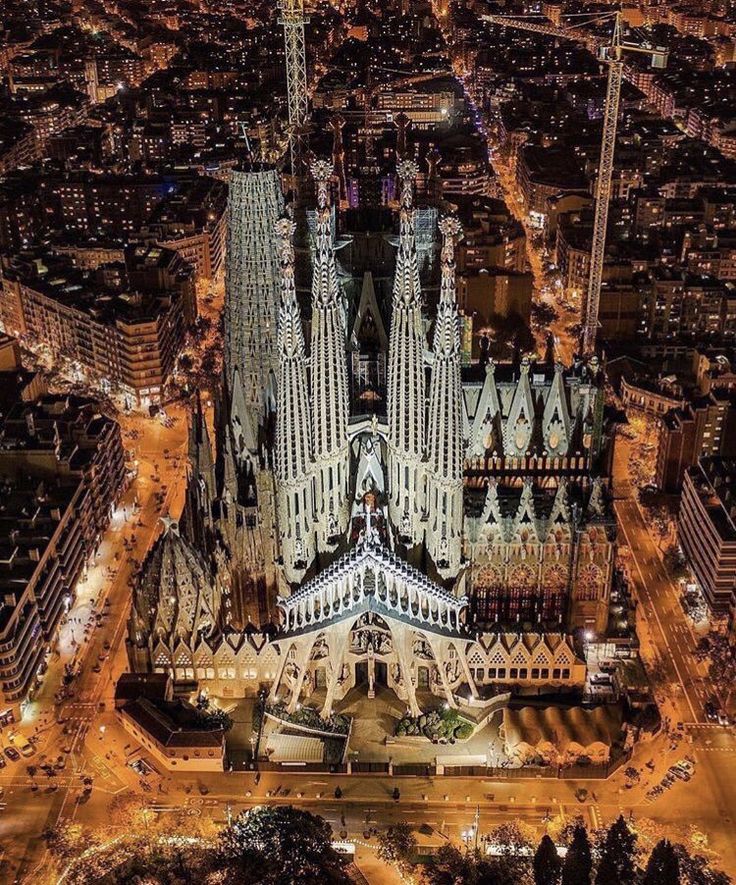
Sagrada Familia inside and out
Sagrada Familia inside surprises no less than at first glance at the facades of this majestic architectural monument. Every year, crowds of tourists explore the details inside this temple. It does not lose its positions in the ranking of the most popular sights of the city. Unfortunately, during his lifetime, Antonio Gaudí was unable to complete his main project.
Sagrada Familia does not belong to the lands belonging to the church. In this regard, equating this landmark with a diocesan church is a common mistake. Inside you feel the atmosphere of light and magic, there is no usual severity of such buildings.
Every year, the Sagrada Familia attracts about three million travelers.
In order to get inside the Sagrada Familia, you will have to stand in a long queue. It is best to purchase tickets in advance online via the link.
Sagrada Familia inside
Sagrada Familia inside and out: features of the temple
- To complete the project, it is necessary to build 4 more towers (120 meters each) in memory of the Evangelists. The Sagrada Familia, inside and out, is due to receive its final look by 2026.
Sagrada Familia inside
- At the first glance at the Sagrada Familia, one feels the scale and grandeur of the attraction. Beautiful forms and a non-standard approach to design are also noticeable inside the temple. Antonio Gaudi made it his principle to refuse standard solutions, experimenting with architectural forms.
Sagrada Familia inside is characterized by curvilinear outlines that merge perfectly into a single ensemble.
- Now the pace of building facades has been seriously increased. For decorations and decorations inside the temple, the best specialists in their field are involved. Stable funding ensures strict compliance with the construction plan of the Sagrada Familia. The only difficulty now is the processing of stone blocks.
Almost all the features of the Sagrada Familia inside and out can be read in the material.
The history of the Sagrada Familia
Initially, the financing of the temple fell on the shoulders of the parishioners. In 1874, the accumulated amount was enough to start implementing the Sagrada Familia project. After 7 years, a suitable plot of land was bought in the immediate vicinity of the city for the construction of a future architectural masterpiece. Since then, Barcelona has grown significantly in terms of area.
The Sagrada Familia is currently located in the central part of the city.

The original version of the Sagrada Familia was entrusted to design Francisco del Villar. His ideas were that outside and inside it is worth sticking to a neo-Gothic basilica. A huge asp with seven chapels was designed. Disagreements with customers constantly hampered the design of the Sagrada Familia. Not having worked even a year, Francisco del Villar was suspended from work and left the project.
The Sagrada Familia is located in the central part of the city
The work on the Sagrada Familia was entrusted to Antonio Gaudi, who at that time had already managed to find his own creative style and decided on fundamental changes. Gaudi believed that outside and inside the building should be in harmony with the natural features of the territory. The height of the Sagrada Familia was not to exceed 170 meters. Antonio chose Mount Montjuic as the main natural landmark.
Sagrada Familia
7 years after the start of construction inside the temple, work on the crypt was completed.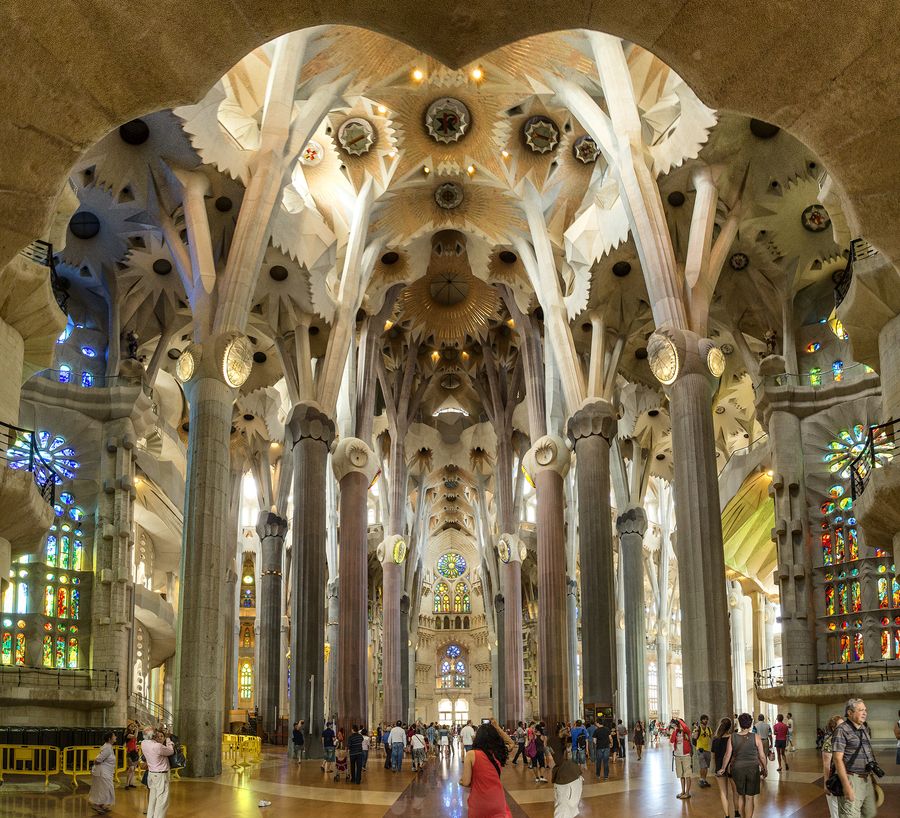
Inside the temple, the work was extremely slow, the facades were erected for a long time. This was due to a lack of funding, because the budget was determined solely by donations from parishioners. During the construction of the apse, it was possible to obtain a significant amount, which made it possible to make adjustments to the project. It was decided to additionally develop several towers that would improve the appearance of the facades. Inside, each of them had unique features. The architect paid a lot of attention to decorations for the external appearance. Sagrada Familia inside surprises with inventive decorative elements.
Features of the external facades of the Sagrada Familia
At first glance, the attraction focuses on three striking facades:
- Rozhdestva
- Glory
- Passion of Christ
Initially, the architect planned to experiment with shades of ceramics for decoration, but then rejected this idea.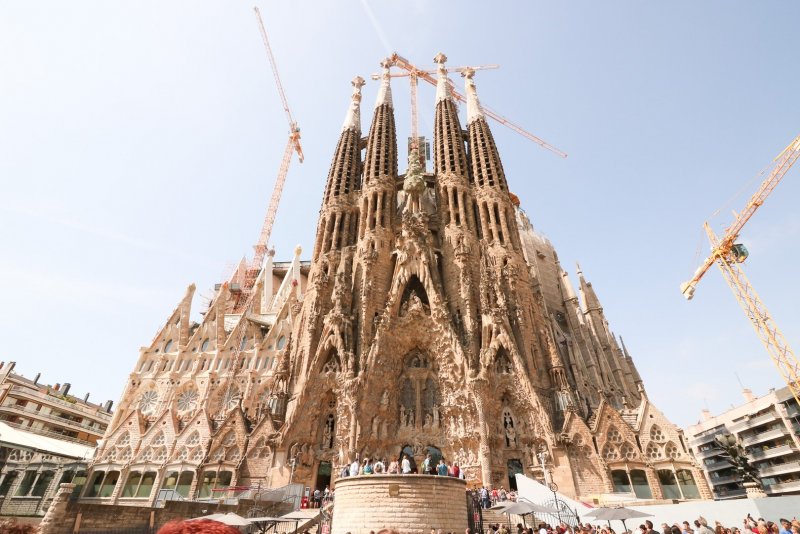
According to the architect, the Nativity facade is the main ideological symbol of the Sagrada Familia, which determines the stylistic features of the temple. To decorate this facade, Gaudí resorted to elements of wildlife. Inside the Sagrada Familia, work was in full swing on the construction of the cloister.
The Sagrada Familia acquired at the beginning of the last century close to the appearance that now exists outside and inside the sights.
In 1909, it was decided to add a parochial school to the Sagrada Familia project. It was built in just a year, striking with unusual architectural solutions both inside and out.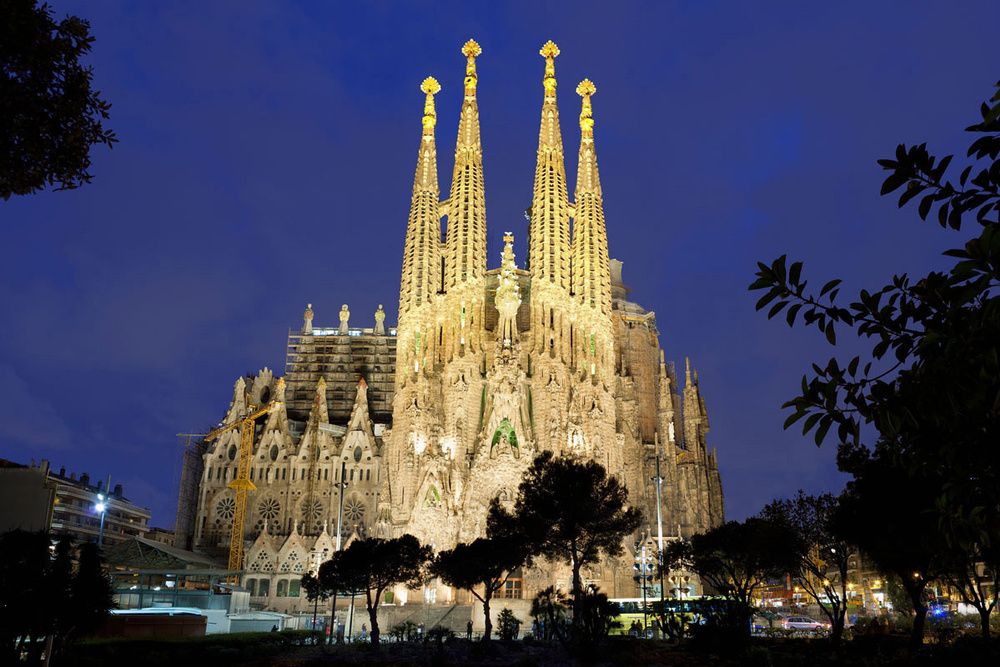
The Nativity Façade was completed in 1925. Further construction of facades took place under the guidance of students and followers of the architect. An amazing feature of the Sagrada Familia is the 100-meter column of St. Barnabas.
Sagrada FamiliaSagrada Familia
The tragic death of Antoni Gaudí
- On June 7, 1926, a tragedy occurred that claimed the life of one of the most talented architects in the history of mankind. Enthusiasm for working on my project and a departure from ordinary worldly values played a significant role in what happened.
- After Antonio was hit by a tram, he landed in a hospital for the poor. This was facilitated by a rather modest appearance, lack of money and documents with him.
- The next day, Gaudí was identified by the Sagrada chaplain, but the architect’s condition was critical.
- June 10, 1926 Antoni Gaudí left this world.
He was buried inside the temple under construction (directly in the crypt). Such a decision, according to those working on the Sagrada Familia project, would allow him not to part with the main project of his life.
What happened next
Further work on the construction of the temple was entrusted to one of the most talented students of Gaudi – Domenech Sugranes. He approached his work with trepidation, creating unique solutions that can be admired inside and outside the sights.
By 1930, the remaining columns of the Nativity facade were completed. The civil war of 1936 seriously slowed down the construction of the Sagrada Familia. The burnt drawings that defined the appearance of the Sagrada Familia inside and out became a great loss. At 19Domenech Sugranes died in 38, not having time to realize his ideas.
In 1952, successful results were achieved in the construction of the temple. Sagrada Familia inside received an original staircase, unusual lighting.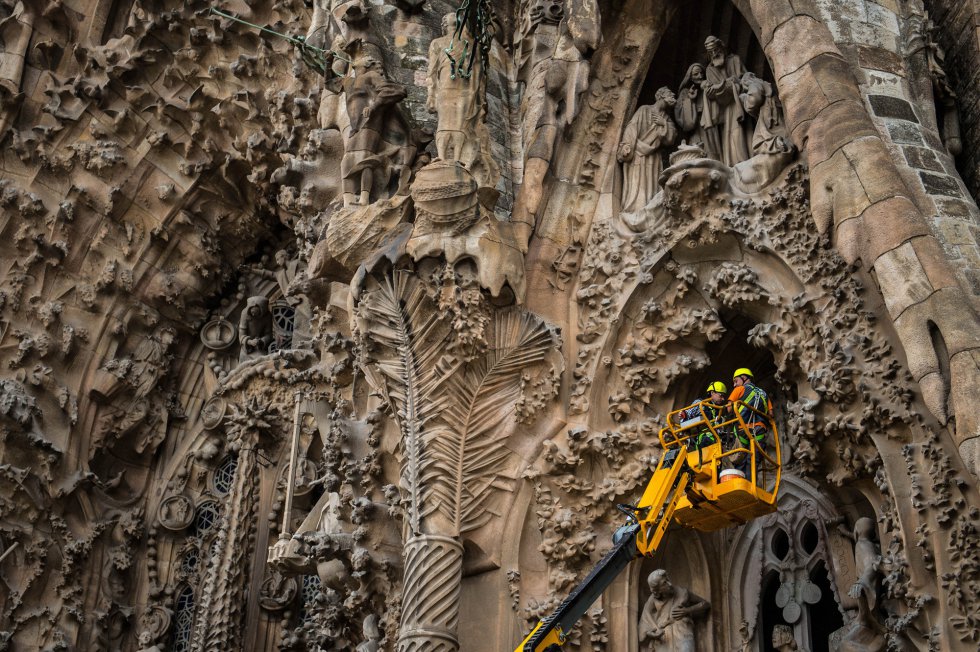
Passion façade details
Towers to adorn the Passion façade completed by 1977. Inside the temple, they were actively engaged in decorations in the form of stained-glass windows and sculptures. There is a single motif for jewelry – the Resurrection of Jesus Christ.
The rate of construction of the temple is increasing from year to year. However, only:
- transepts
- nave
- their facades and vaults
received their final look
In 2010, the construction of the apse and crossroads was completed. They serve as the basis for two more towers. The height of the main tower (decorated with a cross) is 170 meters. The tower above the apse is dedicated to the Virgin Mary.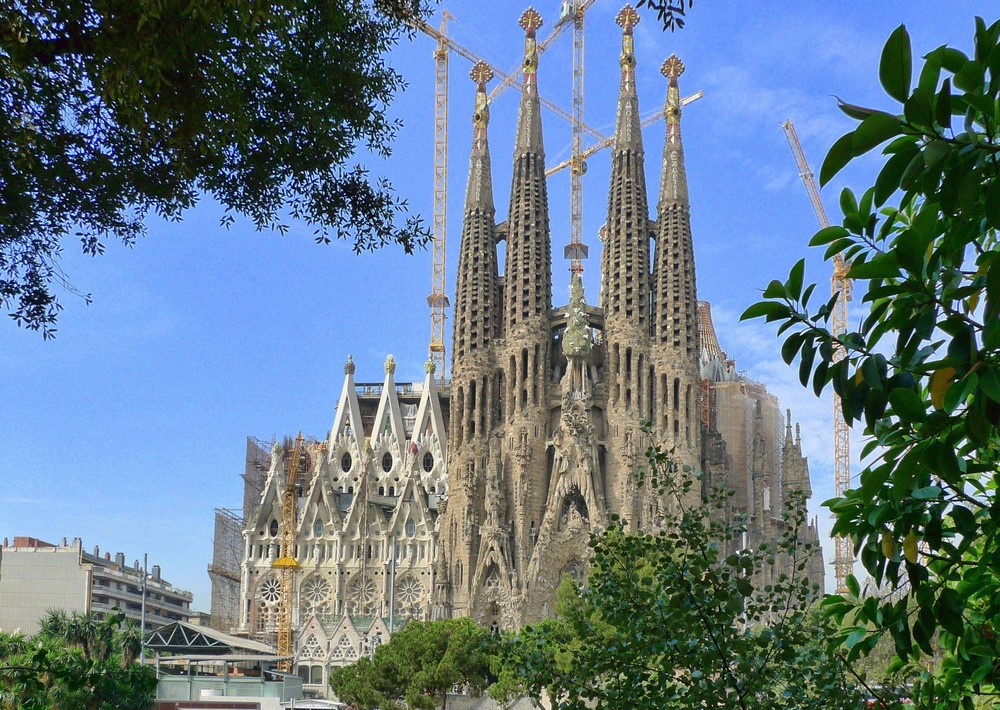
How to get inside the temple: buying tickets
Sagrada Familia inside is striking in how reverently they approached the decoration process with the help of stucco, stained glass and mosaics. The resulting play of light and form is a truly unique achievement.
The lines of those wishing to get into the temple are quite impressive. If you want to explore the inside of the Sagrada Familia in detail, you should think about purchasing tickets in advance. Now the easiest way to do this is through the Internet using the link without extra charges and commissions.
- Sagrada Familia is available inside for 20€.
- From October to March, the attraction opens its doors to those who wish from 09:00 to 18:00.
- April – September: from 09:00 to 20:00.
- The earlier the ticket is purchased, the better.
Sagrada Familia inside attracts crowds of visitors thanks to its unique architectural solutions and original decorations. Even in its unfinished form, this temple is an iconic landmark in Barcelona.
Detailed instructions on how to purchase tickets are available in the material.
Address
Barcelona, Via Mallorca, 401
You can view the best hotels nearby using the link on Booking.com.
How to get to Sagrada Familia
Subway : station Sagrada Familia blue and purple lines L2 and L5
Buses : 19, 33, 34, 43, 44, 50, 51.
Sagrada Familia opening hours Barcelona
Summer season : April – September – daily from 9 am to 8 pm.
Winter season : October – March – daily from 9 am to 6 pm.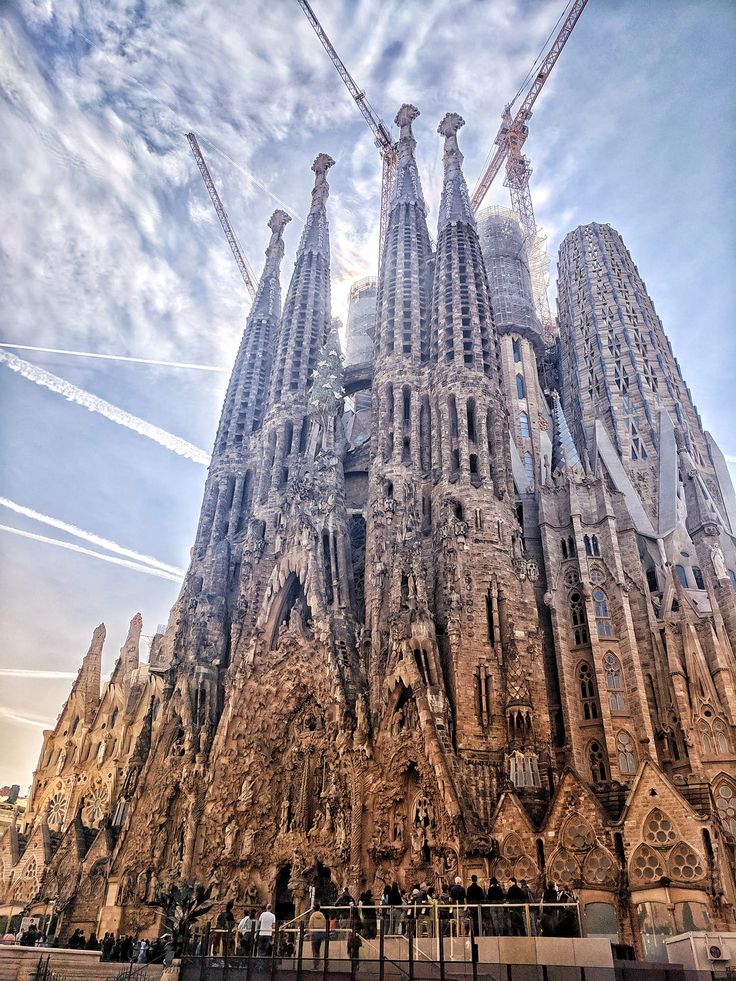
Holidays (December 25, 26, January 1, 6) — from 9 am to 2 pm.
- How to avoid queues at Barcelona attractions. Tickets for the Sagrada Familia and Park Güell skip the line.
- How not to be deceived by local taxi drivers. Order a taxi in advance with fixed rates online. The most reliable service for ordering a taxi – KiwiTaxi .
- Excursions in Barcelona with locals will help you get to know this city for real. The best way to get comfortable in an unfamiliar city is to walk around it with a person who has lived here for many years.
- We advise you to take out travel insurance so that there are no unpleasant surprises while traveling to Barcelona.
- Barcelona City Pass is a one-stop card that makes organizing your holiday in Barcelona easier and saves you a lot of time and money.
-
Barcelona Hotels: is our selection and recommendations.
- Bus Turistic is a tourist bus and a great way to get to all the necessary monuments of Barcelona quickly, with a breeze and comfort.
- Drimsim is a universal international SIM card and a free travel application. Best prices, fast internet and worldwide calls.
photos and reviews – NGS.TOURISM
Show map
Hide map
Sagrada Familia
Once in Barcelona, you can take a long walk through the narrow streets of the Gothic Quarter or along the noisy Rambla, you can enjoy the breeze in the Olympic port and dance with the Magic Fountains on Montjuic. But sooner or later, the legs themselves lead to the streets of Mallorca, the eyes rise to the sky, and the heart skips a couple of beats – this is how everyone who first met the Sagrada Familia tete-a-tete reacts.
Speak , Chairman of the Society of St.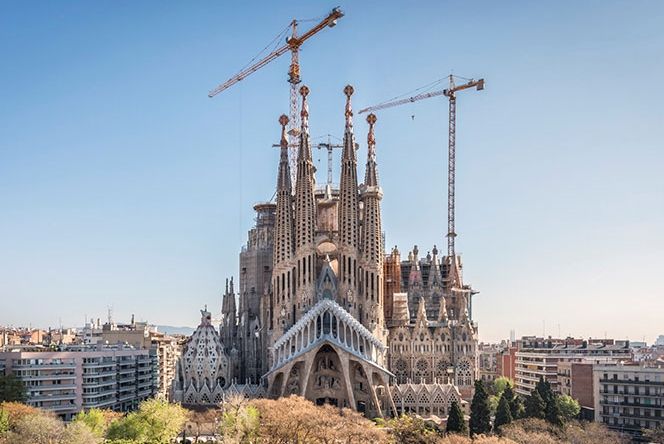
From 1882 to the present day, work has been in full swing on the largest architectural masterpiece of recent centuries. Initially, the project was developed by Francisco del Villar and the Sagrada Familia could be lost among other outstanding buildings in Barcelona, being mediocre. But Gaudi doomed him to eternal glory! The genius was guided solely by his intuition, and his contemporaries shook their heads and openly mocked his ideas.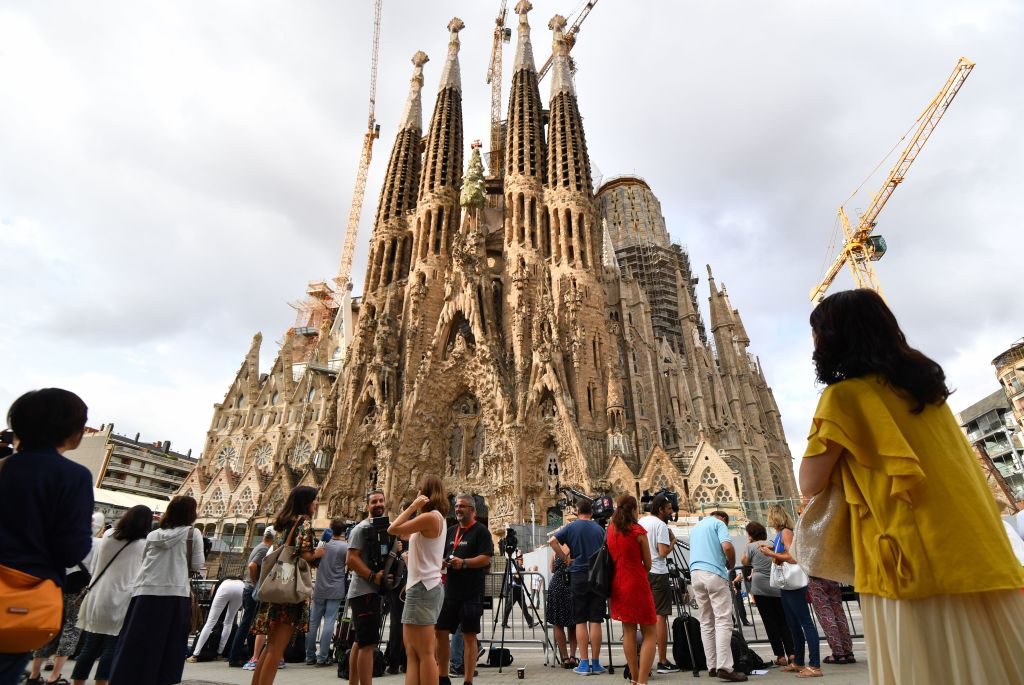
The brain explodes with fireworks at the thought that the already magnificent building could be even more beautiful than . The facades were planned to be lined with ceramics and glass of various colors, on which the sun would dance, turning the temple into a giant jewel.
What’s the real deal? Nativity, Glory and Passion of Christ – three facades, three stories come to life, animated by the skill of the sculptor. The building itself is an intricacies of towers, each of which is elegantly decorated and not just anyhow, but jewelry. When Gaudi was asked why so many efforts, because people from the earth cannot see even half, he answered that not people, so angels will be able to admire the fruits of his labors.
In fairness, it should be noted that Gaudi managed to come to grips with only the first of the listed facades.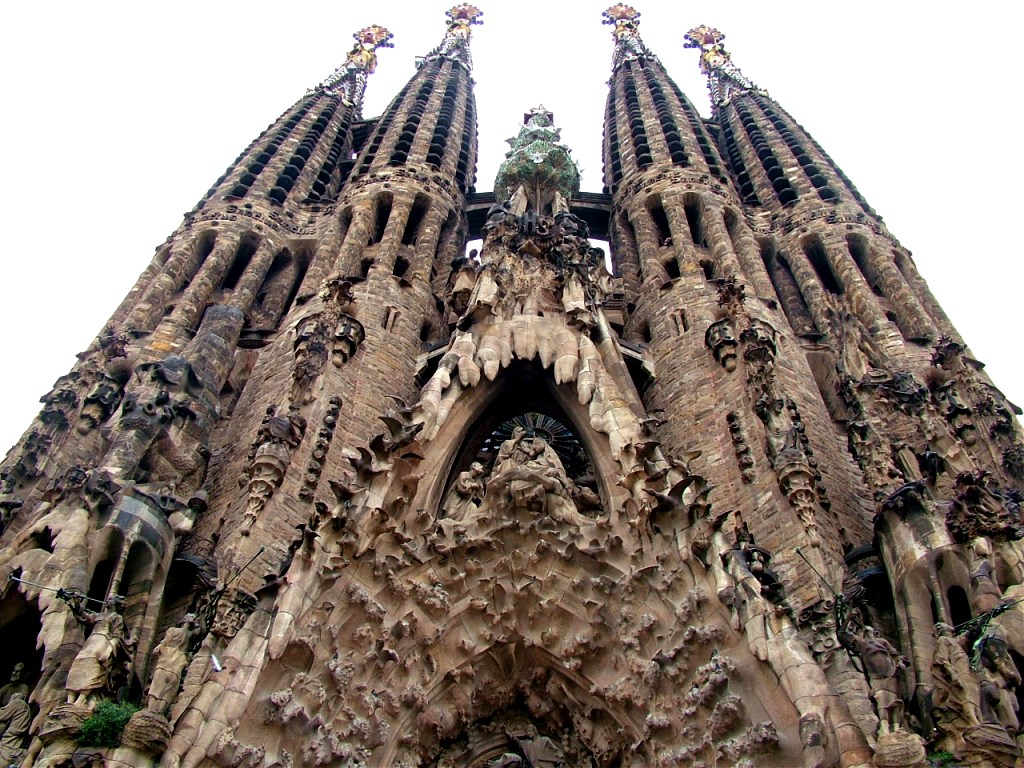
In November 1925, the 100-meter bell tower of St. Barnabas (the only one completed by Antonio Gaudi himself). The first 40 years of construction dressed the temple in decor of liturgical and biblical quotations, religious symbols and all kinds of sculptures .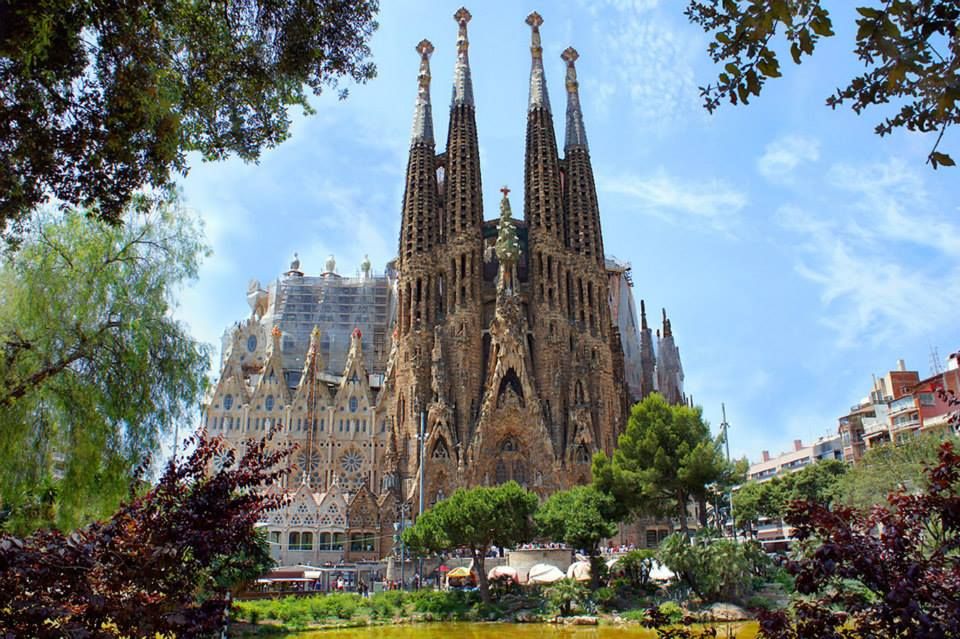
In June 1926 the first tram passed through Barcelona. Passed and took with him the life of Antoni Gaudí . Since the architect was dressed modestly, he had no documents with him, he ended up in a hospital for the poor, where they provide appropriate assistance. Gaudi was identified a day later, but time was lost – Antonio died a few days before his 74 years. The genius was buried in the crypt of the still unfinished temple, so that Gaudi would “look after” the work even from the other world.
one of his most talented students, Sugranes , who worked with Antonio for almost 25 years, undertook to continue the work of the master. With his help, three final columns appear on the facade of the Nativity, a ceramic cypress, and then the Civil War begins and construction is suspended. At the same time, the fire looks into the workshop of Gaudi, absorbing all the models and drawings of the Sagrada Familia.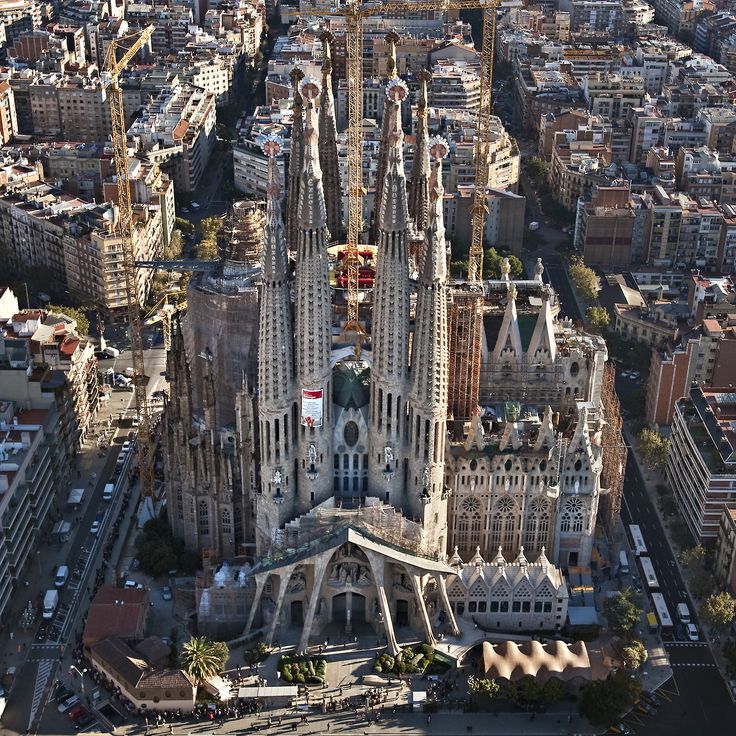
By the way, the temple was built solely on donations, which were few after the war. So, they returned to the Sagrada Familia only in 1952, continuing to decorate the facade of the Nativity. The Passion was approached 2 years later, focusing on Gaudi’s drawings, created at the turn of the 19th and 20th centuries. In 1061, the crypt was brought to mind, today it houses exposition , connected with the peculiarities of the construction of the temple and with the author of the project.
Soon 4 towers appeared on the side of the Passion façade, from the end of the 80s to the beginning of the 21st century, work was in full swing on sculptures and stained-glass windows telling about the Resurrection of Christ.
Last years construction is progressing by leaps and bounds , but as if through the looking glass, to stay in place, you need to run as fast as you can, and to move forward, you need to run even faster.
Next in line was 4 more Evangelist towers appeared to the world: Luke, John, Matthew and Mark; on each of which there will be a sculpture: a calf, an eagle, an angel and a lion, respectively. The huge tower of Jesus will be crowned with a gigantic cross, the rest – bunches of grapes and sheaves of wheat – symbols of Communion.
If everything goes without a hitch, the temple will be completed in 2026.
Gaudi knew that such a large-scale project as the Sagrada Familia would outlive the creator, and therefore he drew for the future . He wanted the temple to be simple and ingenious at the same time, to be a triumph of geometry – ellipses, helicoids, conoids, hyperboloids and hyperbolic paraboloids. The intersections of these figures gave rise to straight lines that simplified the connection of internal structures into a single composition.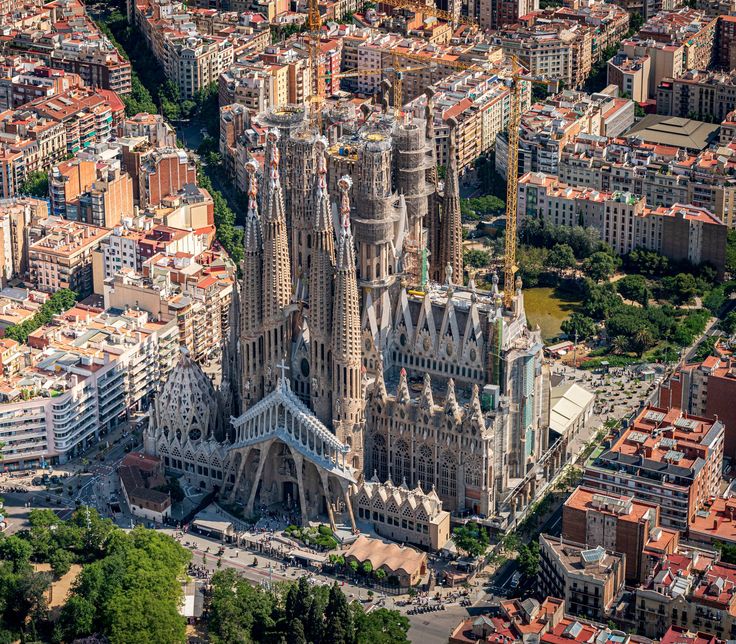
There is still enough money for Gaudi’s ideas: the parishioners were supported by Catholics and believers from all over the world, even representatives of other faiths. Especially a lot of money comes from Japan. But a century ago, Gaudí had to beg for donations. The lack of material support was the reason for the loss of so many years!
Another obstacle to the happy ending of the Sagrada Familia is the complexity of the work. This is especially true for the formation of stone blocks of eccentric shapes. Even computer models do not exclude subsequent fitting and manual processing.
Sagrada Familia is beautiful not only in its “face” but also in its “soul”. The shapes of the columns and other interior elements transform the space. There is not a single piece of surface on which there would be no mosaic, painting, stucco, fresco or sculpture. But there is no need to talk about piling up – everything is harmonious, logical, geometric.
When the numbness passes and a person who has admired the facades of crosses the threshold of the Sagrada Familia , a second wave of shock rolls over him – goosebumps run from the grandeur and beauty of the interior.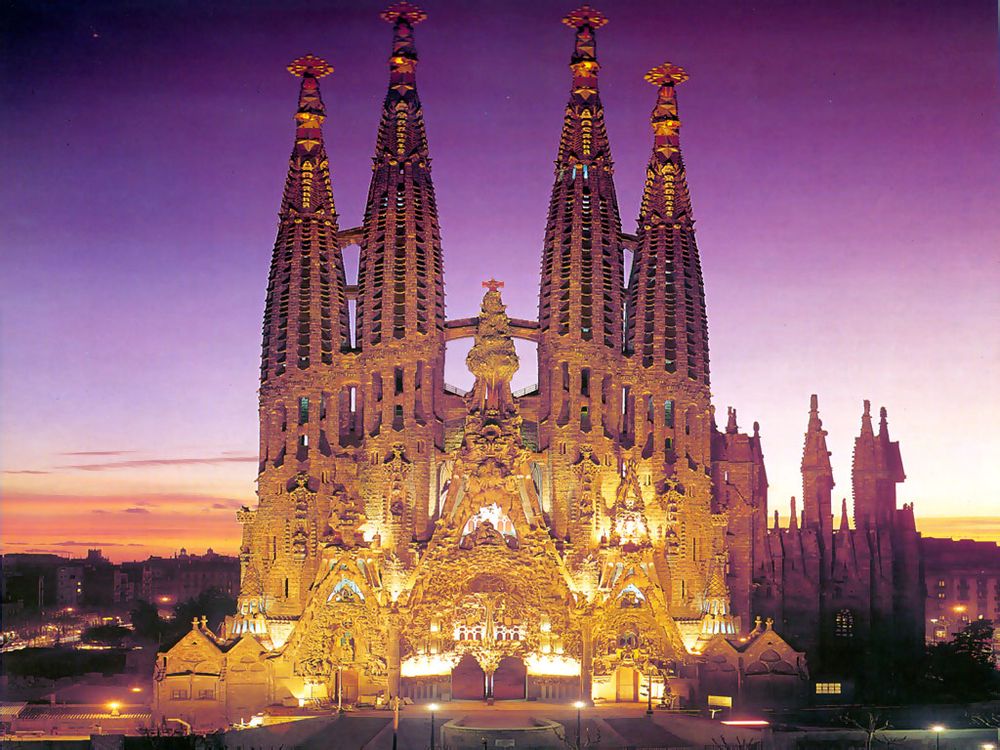
Up to 10,000 tourists experience this every day. Entrance to the temple is paid , the visit can be individual and accompanied by a guide.
An important point : Sagrada Familia is located on non-church land, built on donations from ordinary people and was lit only in 2010. It is a church, but by no means a cathedral. There can be only one cathedral in the city; this role in Barcelona is played by the cathedral in the Gothic quarter.
190 views for April,
238 for March,
13570 total
“data-postfix=”
“>
-
Rafting in Maslyanino
Nikonovo-Legostaevo 5 days to sail?
Kostya Koshkin, 05.

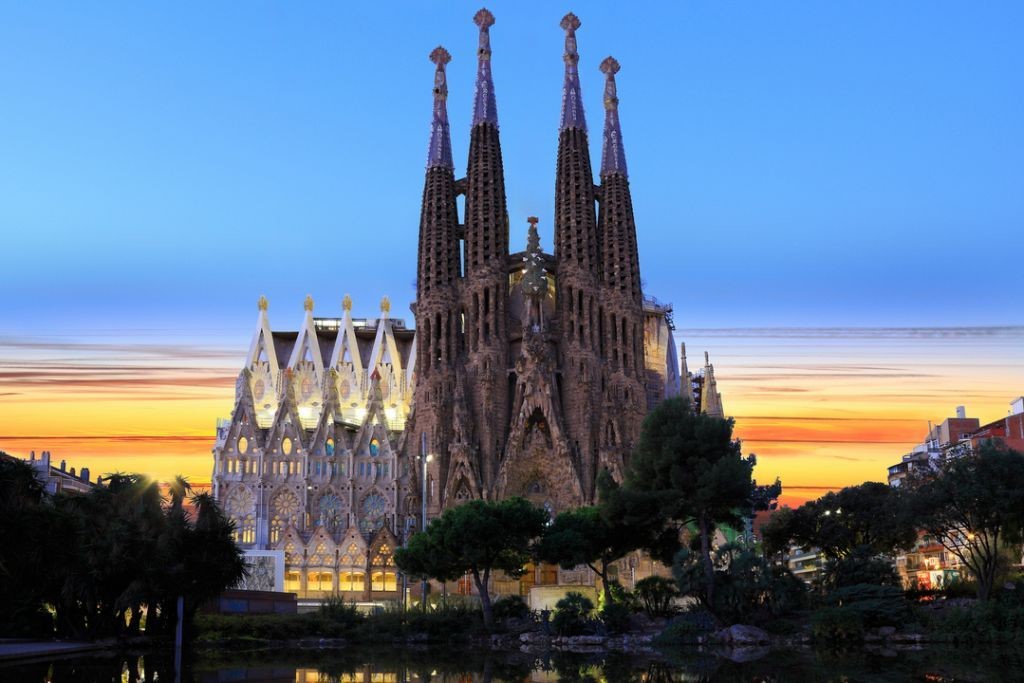 Sagrada Familia inside is characterized by curvilinear outlines that merge perfectly into a single ensemble.
Sagrada Familia inside is characterized by curvilinear outlines that merge perfectly into a single ensemble. 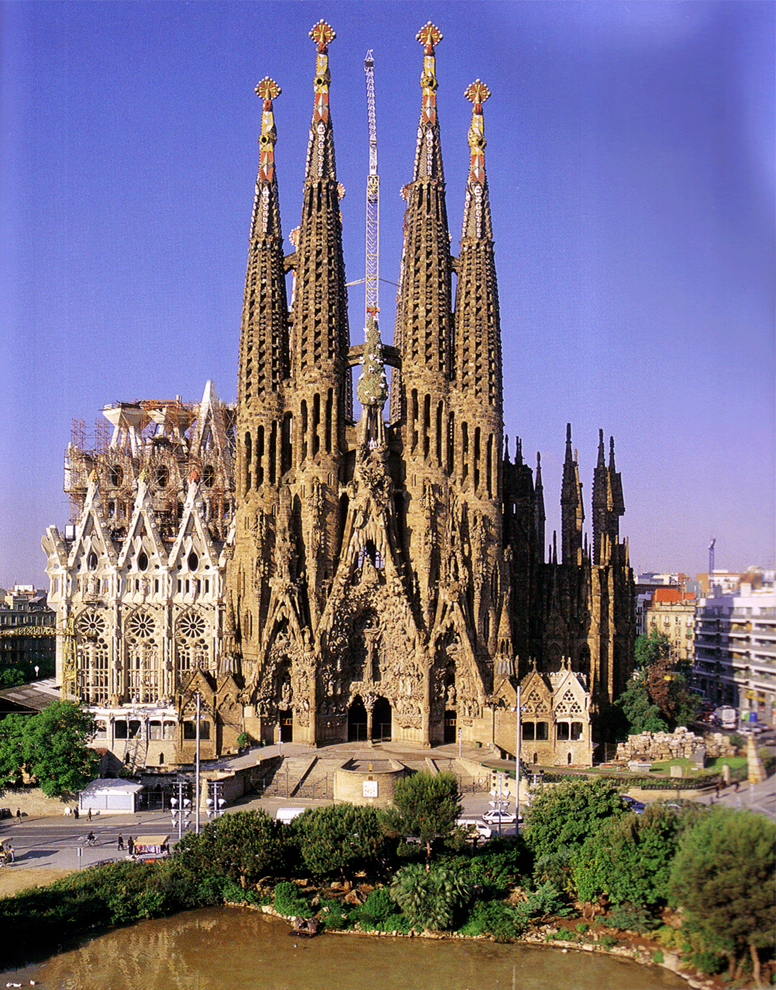
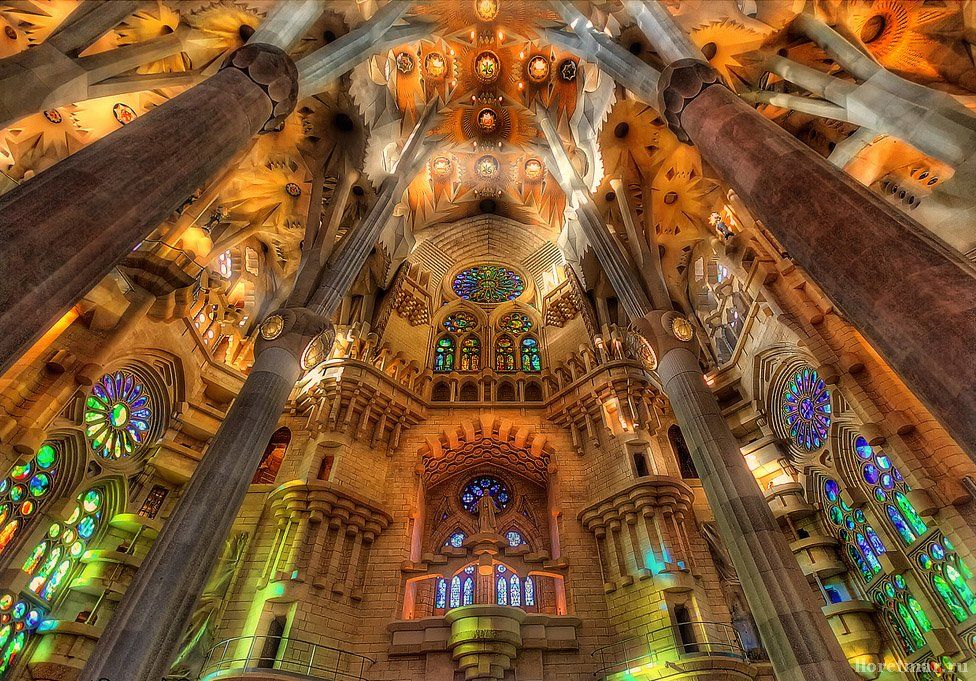 He was buried inside the temple under construction (directly in the crypt). Such a decision, according to those working on the Sagrada Familia project, would allow him not to part with the main project of his life.
He was buried inside the temple under construction (directly in the crypt). Such a decision, according to those working on the Sagrada Familia project, would allow him not to part with the main project of his life. 